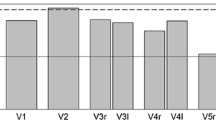Abstract
Background
Lumbar spinal stenosis (LSS) is commonly assessed on MRI by measuring dural sac cross-sectional area (DSCA). A new method, morphological grading A–D, has recently been introduced as an alternative method.
Objective
The aim of this study is to compare these two different methods for assessing LSS on MRI and study their reliability and intercorrelation.
Methods
On pretreatment MRI of 84 patients, two experienced radiologists independently classified level L2/L3, L3/L4 and L4/L5 as no, relative or significant stenosis using both methods. Agreement was analyzed by weighted Kappa. The correlation between the two methods was analysed using Spearman correlation, and visualized in a box plot.
Results
The interobserver agreement (95 % CI) was 0.69 (0.61–0.77) and 0.65 (0.56–0.74), respectively. The intraobserver agreements for DSCA were 0.77 (0.60–0.74) and 0.80 (0.66–0.93). On morphological grading A–D it was 0.78 (0.65–0.92) and 0.81 (0.68–0.94). The correlation coefficient between the two methods was 0.85 (p < 0.001). Grades C and D were under the limit value for significant stenosis using the DSCA.
Conclusions
The study shows that the inter- and intraobserver agreements of DSCA and morphological grading A–D were acceptable and their intercorrelation is strong. Both methods may be used in the MRI evaluation of LSS.


Similar content being viewed by others
References
Verbiest H (1975) Pathomorphologic aspects of developmental lumbar stenosis. Orthop Clin N Am 6:177–196
Amundsen T, Weber H, Lilleås F et al (1995) Lumbar spinal stenosis. Clinical and radiologic features. Spine 20:1178–1186
Genevay S, Steven J, Atlas MDM (2010) Lumbar spinal stenosis. Best Pract Res Clin Rheumatol 24:253–265. doi:10.1016/j.berh.2009.11.001
Cheng F, You J, Rampersaud YR (2010) Relationship between spinal magnetic resonance imaging findings and candidacy for spinal surgery. Can Fam Physician 56:e323–e330
Schönström N, Lindahl S, Willén J, Hansson T (1989) Dynamic changes in the dimensions of the lumbar spinal canal: an experimental study in vitro. J Orthop Res 7:115–121. doi:10.1002/jor.1100070116
Schönström N, Bolender NF, Spengler DM (1985) The pathomorphology of spinal stenosis as seen on CT scans of the lumbar spine. Spine 10:806–811
Ogikubo O, Forsberg L, Hansson T (2007) The relationship between the cross-sectional area of the cauda equina and the preoperative symptoms in central lumbar spinal stenosis. Spine 32:1423–1428. doi:10.1097/BRS.0b013e318060a5f5 (discussion 1429)
Boden SD, McCowin PR, Davis DO et al (1990) Abnormal magnetic-resonance scans of the cervical spine in asymptomatic subjects. A prospective investigation. J Bone Joint Surg Am 72:1178–1184
Jensen MC, Brant-Zawadzki MN, Obuchowski N et al (1994) Magnetic resonance imaging of the lumbar spine in people without back pain. N Engl J Med 331:69–73. doi:10.1056/NEJM199407143310201
Sigmundsson FG, Kang XP, Jönsson B, Strömqvist B (2011) Correlation between disability and MRI findings in lumbar spinal stenosis. Acta Orthop 82:204–210. doi:10.3109/17453674.2011.566150
Hirasawa Y, Bashir WA, Smith FW et al (2007) Postural changes of the dural sac in the lumbar spines of asymptomatic individuals using positional stand-up magnetic resonance imaging. Spine 32:E136–E140. doi:10.1097/01.brs.0000255202.94153.ca
Ishimoto Y, Yoshimura N, Muraki S et al (2012) Prevalence of symptomatic lumbar spinal stenosis and its association with physical performance in a population-based cohort in Japan: the Wakayama Spine Study. Osteoarthr Cartil 20:1103–1108. doi:10.1016/j.joca.2012.06.018
Schizas C, Kulik G (2012) Decision-making in lumbar spinal stenosis. A survey on the influence of the morphology of the dural sac. J Bone Joint Surg 94-B:98–101. doi:10.1302/0301-620X.94B1
Schizas C, Theumann N, Burn A et al (2010) Qualitative grading of severity of lumbar spinal stenosis based on the morphology of the dural sac on magnetic resonance images. Spine 35:1919–1924. doi:10.1097/BRS.0b013e3181d359bd
Ker M (1991) Issues in the use of kappa. Invest Radiol 26:78–83
Steurer J, Roner S, Gnannt R et al (2011) Quantitative radiologic criteria for the diagnosis of lumbar spinal stenosis: a systematic literature review. BMC Musculoskelet Disord 12:175. doi:10.1186/1471-2474-12-175
Andreisek G, Imhof M, Wertli M et al (2013) A systematic review of semiquantitative and qualitative radiologic criteria for the diagnosis of lumbar spinal stenosis. Am J Roentgenol 201:W735–W746. doi:10.2214/AJR.12.10163
Athiviraham A, Yen D, Scott C, Soboleski D (2007) Clinical correlation of radiological spinal stenosis after standardization for vertebral body size. Clin Radiol 62:776–780. doi:10.1016/j.crad.2007.02.011
Boden SD, Davis DO, Dina TS et al (1990) Abnormal magnetic-resonance scans of the lumbar spine in asymptomatic subjects. A prospective investigation. J Bone Joint Surg Am 72:403–408
Jensen MC, Brant-Zawadzki MN (1994) Magnetic resonance imaging of the lumbar spine in people without back pain. J Med. doi:10.1016/j.ejps.2008.03.002
Mattei TA (2013) A gaze beyond the surface. Neurosurgery 72:E135–E140. doi:10.1227/NEU.0b013e3182752bb7
Sirvanci M, Bhatia M, Ganiyusufoglu KA et al (2008) Degenerative lumbar spinal stenosis: correlation with Oswestry Disability Index and MR imaging. Eur Spine J 17:679–685. doi:10.1007/s00586-008-0646-5
Wassenaar M, van Rijn RM, van Tulder MW et al (2012) Magnetic resonance imaging for diagnosing lumbar spinal pathology in adult patients with low back pain or sciatica: a diagnostic systematic review. Eur Spine J 21:220–227. doi:10.1007/s00586-011-2019-8
Sipola P, Leinonen V, Niemeläinen R et al (2011) Visual and quantitative assessment of lateral lumbar spinal canal stenosis with magnetic resonance imaging. Acta Radiol 52:1024–1031. doi:10.1258/ar.2011.110083
Henderson L, Kulik G, Richarme D et al (2011) Is spinal stenosis assessment dependent on slice orientation? A magnetic resonance imaging study. Eur Spine J 21:760–764. doi:10.1007/s00586-011-1857-8
Conflict of interest
None.
Author information
Authors and Affiliations
Corresponding author
Rights and permissions
About this article
Cite this article
Lønne, G., Ødegård, B., Johnsen, L.G. et al. MRI evaluation of lumbar spinal stenosis: is a rapid visual assessment as good as area measurement?. Eur Spine J 23, 1320–1324 (2014). https://doi.org/10.1007/s00586-014-3248-4
Received:
Revised:
Accepted:
Published:
Issue Date:
DOI: https://doi.org/10.1007/s00586-014-3248-4




